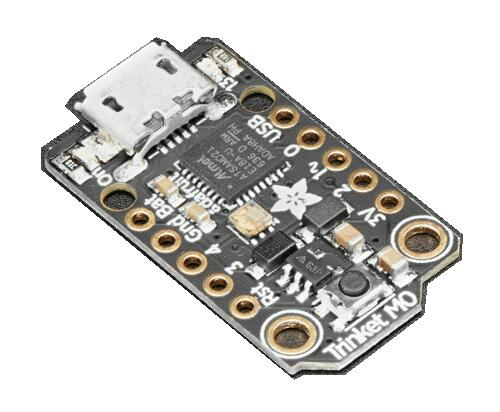Adafruit Trinket M0
Overview
The Adafruit Trinket M0 is a tiny (27 mm x 15 mm) ARM development board with an onboard RGB LED, USB port, and range of I/O broken out onto 5 pins.

Hardware
ATSAMD21E18A ARM Cortex-M0+ processor at 48 MHz
256 KiB flash memory and 32 KiB of RAM
Internal trimmed 8 MHz oscillator
A user LED
An RGB DotStar LED
Native USB port
One reset button
Supported Features
The adafruit_trinket_m0 board configuration supports the following hardware features:
Interface |
Controller |
Driver/Component |
|---|---|---|
NVIC |
on-chip |
nested vector interrupt controller |
Flash |
on-chip |
Can be used with LittleFS to store files |
SYSTICK |
on-chip |
systick |
WDT |
on-chip |
Watchdog |
GPIO |
on-chip |
I/O ports |
PWM |
on-chip |
Pulse Width Modulation |
USART |
on-chip |
Serial ports |
SPI |
on-chip |
Serial Peripheral Interface ports |
USB |
on-chip |
USB device |
Other hardware features are not currently supported by Zephyr.
The default configuration can be found in the Kconfig file boards/arm/adafruit_trinket_m0/adafruit_trinket_m0_defconfig.
Connections and IOs
The Adafruit Trinket M0 Learn site 1 has detailed information about the board including pinouts 2 and the schematic 3.
System Clock
The SAMD21 MCU is configured to use the 8 MHz internal oscillator with the on-chip PLL generating the 48 MHz system clock. The internal APB and GCLK unit are set up in the same way as the upstream Arduino libraries.
Serial Port
The SAMD21 MCU has 6 SERCOM based USARTs. On the Trinket, SERCOM0 is the Zephyr console and is available on pins 3 (RX) and 4 (TX). SERCOM2 is available on pins 2 (RX) and 0 (TX).
PWM
The SAMD21 MCU has 3 TCC based PWM units with up to 4 outputs each and a period
of 24 bits or 16 bits. If CONFIG_PWM_SAM0_TCC is enabled then LED0 is
driven by TCC0 instead of by GPIO.
SPI Port
The SAMD21 MCU has 6 SERCOM based SPIs. On the Trinket, SERCOM1 is used to drive the DotStar RGB LED. SERCOM0 can be put into SPI mode and used to connect to devices over pin 2 (MISO), pin 4 (MOSI), and pin 3 (SCK).
USB Device Port
The SAMD21 MCU has a USB device port that can be used to communicate with a host PC. See the USB device support samples sample applications for more, such as the USB CDC ACM Sample Application sample which sets up a virtual serial port that echos characters back to the host PC.
Programming and Debugging
The Trinket M0 ships the BOSSA compatible UF2 bootloader. The bootloader can be entered by quickly tapping the reset button twice.
Additionally, if CONFIG_USB_CDC_ACM is enabled then the bootloader
will be entered automatically when you run west flash.
Flashing
Build the Zephyr kernel and the Hello World sample application:
west build -b adafruit_trinket_m0 samples/hello_worldConnect the Trinket M0 to your host computer using USB
Connect a 3.3 V USB to serial adapter to the board and to the host. See the Serial Port section above for the board’s pin connections.
Run your favorite terminal program to listen for output. Under Linux the terminal should be
/dev/ttyACM0. For example:$ minicom -D /dev/ttyACM0 -o
The -o option tells minicom not to send the modem initialization string. Connection should be configured as follows:
Speed: 115200
Data: 8 bits
Parity: None
Stop bits: 1
Tap the reset button twice quickly to enter bootloader mode
Flash the image:
west build -b adafruit_trinket_m0 samples/hello_world west flash
You should see “Hello World! adafruit_trinket_m0” in your terminal.
